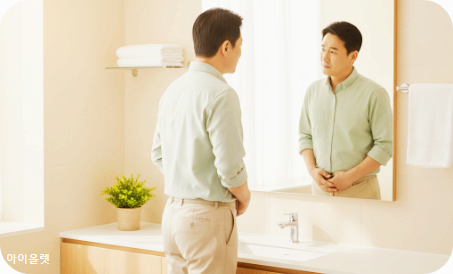암 예방 시리즈 ⑦ 전립선암 – 남성에게 흔하지만 놓치기 쉬운 초기 신호와 관리 전략

나이가 들수록 전립선 문제는 흔해지지만, 바쁜 일상과 “설마 나까지” 하는 마음에 초기 신호를 놓치기 쉽습니다. 특히 전립선비대증과 전립선암의 증상이 겹쳐 보이기 때문에, 대수롭지 않게 넘기다 발견이 늦어지기도 합니다. 지금 내 몸의 작은 신호를 알아보고, 과학적으로 검증된 검사·생활관리 전략을 미리 준비해 두면 대부분의 위험을 크게 낮출 수 있습니다. 오늘은 검사의 타이밍부터 일상 루틴까지, 헷갈리지 않게 한 번에 정리합니다.
“오늘 주제에 맞는 성경 말씀”
“사랑하는 자여 네 영혼이 잘됨 같이 네가 범사에 잘되고 강건하기를 내가 간구하노라.”
짧은 해설: 건강은 영혼·생활 모두의 기초입니다. 스스로를 돌보는 지혜로운 선택(정기검진·생활관리)이 장기적으로 가족과 공동체까지 지키는 길이 됩니다.
스바냐 3:1~8의 깊은 교훈, 예루살렘을 향한 여호와의 책망
예루살렘을 향한 여호와의 책망 스바냐 3:1~8의 깊은 교훈세상은 끊임없이 하나님의 말씀을 떠나 자기 길을 걸어가려 하지만, 결국 주님의 경고와 책망은 반드시 이루어집니다. 스바냐 3장은 예
iallnet12.tistory.com
1. 왜 ‘흔한데’ 놓치기 쉬운가
- 초기엔 무증상이 많음: 전립선암은 초기엔 자각증상이 거의 없거나, 있어도 가볍게 스쳐 지나가기 쉽습니다.
- 증상 겹침: 소변 줄기 약화, 잔뇨감, 야간뇨 같은 하부요로증상(LUTS)은 전립선비대증(BPH), 염증(전립선염)과도 같아 보입니다.
- 문화적 요인: “남자라면 좀 참지” 식의 태도, 민감한 부위라는 이유로 병원 방문을 미루는 경향이 발견을 늦춥니다.
2. ‘초기 신호’ 체크리스트

다음 항목이 새로 생기거나 최근 악화됐다면, 검진을 고려하세요.
- 소변 줄기가 가늘고 약하거나, 끊겼다 이어짐(단속뇨)
- 소변 시작이 더디고(지연뇨) 끝나도 개운치 않은 잔뇨감
- 야간에 2회 이상 깨는 야간뇨, 소변 보는 시간이 길어짐
- 근거 없이 나타난 혈뇨(혹은 사정 시 통증, 혈정액)
- 골반 깊숙한 둔한 통증이 오래가거나, 이유 없이 체중·기력이 줄어드는 느낌
※ 위 증상은 암이 아닌 BPH·염증에서도 흔합니다. 그러나 변화가 생겼다면 ‘원인 확인’을 위해 검진을 받는 것이 안전합니다.
3. 누가 특히 주의해야 하나(위험요인)
- 나이: 50세 이후 위험 증가(가족력이 있으면 더 이른 나이부터 관리).
- 가족력: 1차 친족(아버지·형제)에 전립선암 병력이 있으면 위험 상승.
- 유전 요인: BRCA2 등 특정 유전자 변이가 있으면 상대위험이 더 큽니다.
- 생활 습관: 과체중/비만, 좌식생활, 가공육·포화지방 위주의 식단, 흡연·과음은 전반적 남성 건강에 불리합니다.
4. 검진 전략: PSA·DRE를 ‘똑똑하게’ 활용

- PSA란? 전립선특이항원 단백질 수치(혈액검사)로, 암 가능성을 간접적으로 추정합니다.
- 검사 전 주의: 검진 전 48시간은 사정, 장시간 자전거 타기, 격한 운동, 요로 감염 시기를 피하면 PSA 변동을 줄일 수 있습니다.
- 수치만 보지 말고 ‘추세’를 보라:
- 동일 조건에서 반복 측정하여 경향(velocity)을 확인합니다.
- 자유 PSA 비율(free/total), PSA 밀도(PV 대비) 같은 보조 지표가 불필요한 생검을 줄이는 데 도움을 줍니다.
- 직장수지검사(DRE): 간단하지만 유용한 보완 검사로, 결절·비대·단단함 등을 촉지합니다.
- 영상과 생검의 역할: 필요할 경우 다매개체 MRI(mpMRI)로 위험도를 더 정교하게 가늠하고, 그 결과에 따라 표적 생검을 고려합니다.
- 언제 시작할까?
- 일반적으로 50~69세 사이는 의사와 상의해 개인화된 PSA 검진을 고려합니다.
- 가족력/유전요인이 있으면 45세 전후로 앞당겨 상담합니다.
※ 검진은 **장점(조기발견)**과 **단점(과다진단·불필요한 치료)**이 공존합니다. 의사와 ‘나의 위험도·가치관’을 기준으로 결정하세요.
5. 생활 관리: 오늘 당장 시작할 수 있는 실천들

- 체중·운동: 주 150분 이상 중강도 유산소(빠른 걷기·자전거) + 주 2~3회 근력운동으로 체지방과 인슐린 저항성을 낮춥니다.
- 식단:
- 채소·과일·통곡·견과·올리브유·생선 중심의 지중해형 식사 패턴은 전반적 대사·심혈관·염증 지표 개선에 유리합니다.
- 과도한 가공육·탄음식·포화지방 위주의 식사는 줄이고, 소금·당 과다를 피하세요.
- 칼슘은 음식으로 적정 섭취를 권하며, 과다 보충제는 불필요합니다(개인별로 의사 상담).
- 금연·절주: 담배는 모든 남성암·심뇌혈관 위험을 올립니다. 술은 주당 총량을 줄이는 방향으로 관리하세요.
- 소변 습관 팁(LUTS 완화):
- 저녁 늦게 수분·카페인·알코올 섭취를 줄이고, 잠들기 전 배뇨 습관화.
- 방광훈련(참는 시간을 서서히 늘리기), 규칙적인 배변으로 골반저 부담 줄이기.
- 약·보충제에 대한 오해 바로잡기:
- 피나스테리드/두타스테리드(BPH 치료제)는 PSA를 절반 정도 낮출 수 있어 결과 해석에 주의가 필요합니다.
- 비타민 E·셀레늄·특정 허브 보충제는 예방 효과 근거가 부족하거나, 오히려 해가 될 수 있음이 보고된 바 있으니 의사와 상의 없이 복용하지 마세요.
- 정신·수면 관리: 만성 스트레스와 수면 부족은 호르몬·면역 균형에 악영향을 줍니다. 매일 같은 시간에 자고 일어나며, 스마트폰 블루라이트 노출을 줄이세요.
6. 결과가 ‘암’이라면? 치료만이 답은 아닙니다
- 적극적 감시(Active Surveillance): 저위험군에선 수술 대신 정기 추적만으로도 좋은 예후를 기대할 수 있습니다.
- 수술·방사선·호르몬치료: 병기·위험도·나이·동반질환·선호에 따라 결정을 개인화합니다.
- 부작용 대비: 요실금·발기부전 등 치료 후 삶의 질 문제는 재활·케겔운동·기구·약물로 상당 부분 개선 가능합니다. 치료 전 기대효과·부작용을 충분히 상담하세요.
7. 12주 ‘셀프 플랜’(요약)
- 주 1회: 아침 동일 조건으로 체중·허리둘레 기록.
- 매일: 30분 이상 걷기 + 케겔운동 3세트.
- 매 끼니: 접시의 절반을 채소·통곡으로 채우기, 물 충분히 마시되 취침 3시간 전엔 섭취 축소.
- 분기 1회: 증상 체크리스트 업데이트, 필요 시 진료 예약.
- 연 1회: 나이·위험도에 따라 의사와 PSA 전략 재논의.

마무리
전립선암은 “조기 발견”과 “생활 습관”만으로도 주도권을 되찾을 수 있는 암입니다. 새로운 배뇨 변화나 이유 없는 피로·체중감소 같은 작은 신호를 무시하지 마세요. 검사는 나를 불안하게 만들기 위한 장치가 아니라, 나와 가족을 안심시키는 보험입니다. 오늘부터 한 가지라도 실천하고, 필요한 검진은 미루지 마세요.
침묵속에 다가오는 신장암, 사전에 주는 신호와 건강을 지키는 조기 대응책
암 예방 시리즈 신장암 ⑥ – 침묵 속에 다가오는 신호와 건강을 지키는 조기 대응 전략우리 몸의 신장은 두 개의 작은 장기지만, 체내 노폐물 배출과 혈압 조절, 호르몬 분비 등 중요한 기능을
iallnet.com
다음 편 예고
암 예방 시리즈 ⑧ 대장암 – 침묵의 장내 위험, 변화를 신호로 읽는 법과 검진 가이드로 이어집니다.
출처
대한비뇨의학회 환자 안내자료, 전립선 질환 개요
미국예방서비스특별위원회(USPSTF) 남성 PSA 검진 권고(개인화 의사결정 원칙)
미국비뇨의학회(AUA)·유럽비뇨기과학회(EAU) 전립선암 조기검진/치료 가이드 개요
국제암연구소(IARC)·세계보건기구(WHO) 암 예방 일반 권고
◆ View the English translation. Click below.
Prostate Cancer: Common in Men, Easy to Miss—Early Signals and Prevention Strategies
As men age, prostate issues become more common, yet early signs often get brushed aside as “just getting older.” Because symptoms of benign enlargement can overlap with cancer, many delay seeing a doctor until problems escalate. With the right screening plan and everyday habits, you can lower risk and catch trouble early. Here is a clear, one-stop guide to tests, timing, and daily management.
“Scripture for Today”
“Dear friend, I pray that you may enjoy good health and that all may go well with you, even as your soul is getting along well.”
Brief note: Wise stewardship of health—timely screening and steady habits—protects not only you but those who depend on you.
1) Why it’s common yet easily missed
- Often silent early on—or symptoms are subtle.
- Symptom overlap with BPH/prostatitis blurs the picture (weak stream, nocturia, hesitancy).
- Delay factors: embarrassment, “I’ll be fine,” or fear of bad news.
2) Early-signal checklist
Consider evaluation if these appear or worsen:
- Weaker or intermittent urinary stream; difficulty starting or finishing; persistent sense of incomplete emptying
- Nocturia (waking ≥2 times), visible blood in urine, painful ejaculation or blood in semen
- Deep pelvic ache; unexplained fatigue or weight loss
Note: These can result from non-cancer causes; new change is the key reason to get checked.
3) Who should be extra vigilant (risk factors)
- Age ≥50 (earlier if higher risk)
- Family history in a first-degree relative
- Genetics (e.g., BRCA2 variants)
- Lifestyle: overweight/obesity, sedentary routine, processed/red-meat-heavy diet, tobacco/alcohol excess
4) Smarter screening with PSA & DRE
- PSA: a blood test reflecting prostate activity; levels rise with cancer and with BPH/inflammation.
- Before testing: avoid ejaculation, long cycling, vigorous exercise, and active UTI for ~48 hours to limit PSA spikes.
- Trends over time matter more than a single value; consider free/total PSA, PSA density, and mpMRI to refine risk and reduce unnecessary biopsies.
- DRE: a quick, useful adjunct.
- When to start: shared decision-making is recommended—often ages 50–69, or ~45 if higher risk.
Screening has benefits and trade-offs; align with your physician based on personal risk and values.
5) Everyday prevention you can start now
- Weight & activity: ≥150 min/week moderate cardio + 2–3 strength sessions to improve insulin sensitivity and lower systemic inflammation.
- Diet: plant-forward, whole-food, Mediterranean-style (vegetables, fruit, whole grains, nuts, olive oil, fish); ease up on processed meats and excess saturated fat; prefer dietary over supplemental calcium.
- Quit smoking & curb alcohol to reduce overall cancer/cardiometabolic risk.
- Urinary habits: limit late-evening fluids/caffeine/alcohol; bladder training; regular bowel habits; pelvic-floor (Kegel) work.
- Medications/supplements: 5-alpha-reductase inhibitors (for BPH) can halve PSA, so results need adjusted interpretation; vitamin E/selenium and many “prostate” supplements lack proven prevention benefit—don’t self-medicate; ask your clinician.
- Sleep & stress: consistent bed/wake times; cut late-night screens; integrate relaxation practices.
6) If cancer is diagnosed
- Active surveillance is appropriate for many low-risk cases.
- Surgery, radiation, androgen-deprivation are tailored to stage, risk, age, comorbidities, and personal preferences.
- Quality of life: urinary/sexual side effects often improve with rehab, pelvic-floor training, devices, or medications—discuss expectations ahead of time.
7) A simple 12-week plan (recap)
Weekly waist/weight log; daily 30-minute walk + Kegels; half-plate vegetables and whole grains each meal; reduce evening fluids; quarterly symptom review; annual PSA talk with your clinician adjusted to your risk.
Closing
Prostate cancer is one area where early detection and everyday habits can dramatically shift outcomes. Don’t ignore small changes; and remember—screening is not to scare you but to secure peace of mind. Start one action today, and schedule the conversations you’ve been postponing.
Next in the series
Cancer Prevention Series ⑧: Colorectal Cancer—Reading Silent Gut Signals and Getting Screening Right (no duplication with previous topics).
Sources (English)
- American Urological Association (AUA) Early Detection & Management Summaries
- U.S. Preventive Services Task Force (USPSTF) PSA Screening Recommendation (shared decision-making)
- European Association of Urology (EAU) Prostate Cancer Guidelines
- World Health Organization (WHO) Cancer Prevention Guidance
#prostatecancer, #PSA, #menshealth, #earlydetection, #urology, #prostatehealth, #screening, #BPH, #cancerprevention, #nutrition
끝까지 읽어 주셔서 감사합니다.
◆ 제 다른 글 소개
송언석 위기 봉착, 살인예비음모성 발언으로 징계안 직면
송언석 위기 봉착, 살인예비음모성 발언으로 징계안 직면 정치권은 발언 하나로도 격랑에 휘말리곤 합니다....
blog.naver.com
미국 서부를 강타한 손흥민의 압도적 인기 ‘메시급 퍼포먼스’
미국 서부를 강타한 손흥민의 압도적 인기 “메시급 퍼포먼스” 미국 프로축구 무대에서 손흥민의 존재감은...
blog.naver.com
'건강정보 > 신체건강' 카테고리의 다른 글
| 유방암 – 여성의 생명을 위협하는 가장 흔한 암, 조기 자가검진과 예방 전략 (18) | 2025.09.15 |
|---|---|
| 대장암 – 장내 작은 변화가 말해주는 경고와 예방적 검사 가이드 (14) | 2025.09.14 |
| 침묵속에 다가오는 신장암, 사전에 주는 신호와 건강을 지키는 조기 대응책 (20) | 2025.09.12 |
| 작은 배뇨 이상이 큰 병을 부른다, 방광암을 막는 생활 지혜 (15) | 2025.09.11 |
| 삶의 질을 향상시키는 중장년층을 위한 치아 수명 연장 관리법과 생활 속 실천법 (17) | 2025.09.10 |


